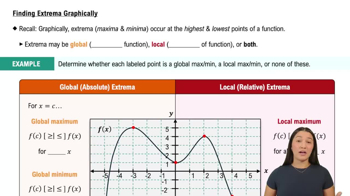Table of contents
- 0. Functions7h 52m
- Introduction to Functions16m
- Piecewise Functions10m
- Properties of Functions9m
- Common Functions1h 8m
- Transformations5m
- Combining Functions27m
- Exponent rules32m
- Exponential Functions28m
- Logarithmic Functions24m
- Properties of Logarithms34m
- Exponential & Logarithmic Equations35m
- Introduction to Trigonometric Functions38m
- Graphs of Trigonometric Functions44m
- Trigonometric Identities47m
- Inverse Trigonometric Functions48m
- 1. Limits and Continuity2h 2m
- 2. Intro to Derivatives1h 33m
- 3. Techniques of Differentiation3h 18m
- 4. Applications of Derivatives2h 38m
- 5. Graphical Applications of Derivatives6h 2m
- 6. Derivatives of Inverse, Exponential, & Logarithmic Functions2h 37m
- 7. Antiderivatives & Indefinite Integrals1h 26m
- 8. Definite Integrals3h 25m
5. Graphical Applications of Derivatives
Intro to Extrema
Problem 4.1.21
Textbook Question
Sketch the graph of a continuous function ƒ on [0, 4] satisfying the given properties.
ƒ' (x) and ƒ'3 are undefined; ƒ'(2) = 0; has a local maximum at x= 1; ƒ has local minimum at x = 2; and ƒ has an absolute maximum at x= 3; and ƒ has an absolute minimum at x = 4 .
 Verified step by step guidance
Verified step by step guidance1
Start by identifying the critical points based on the information given: ƒ'(2) = 0 indicates a local minimum at x = 2, and since ƒ' is undefined at x = 3, this suggests a potential local maximum or a point of inflection.
Plot the local maximum at x = 1, ensuring that the function increases to this point and then decreases afterwards, as it has a local minimum at x = 2.
At x = 2, draw the function so that it reaches a local minimum, meaning the graph should dip down to this point and then rise again towards x = 3.
At x = 3, since it is an absolute maximum, ensure that the function reaches its highest point here before decreasing towards x = 4, where it will have an absolute minimum.
Finally, sketch the graph to reflect that the function is continuous on the interval [0, 4], ensuring that it smoothly transitions through the identified points without any breaks or jumps.
Was this helpful?

 5:58m
5:58mWatch next
Master Finding Extrema Graphically with a bite sized video explanation from Callie
Start learning





